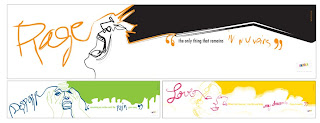Monday, September 28, 2009
Sunday, September 27, 2009
Hypothesis IV
This thesis presents the hypothesis that strategic design, a platform that identifies the needs of constituents, creates innovative solutions, and delivers solutions with financial sustainability in mind (HCD, IDEO), can be used to help poor communities improve their well-being. The current method of subsistence, fundraising and donations, neither guarantees a steady stream of income nor fosters a symbiotic relationship between stakeholders. Such a hypothesis will allow on-going dialogue between stakeholders by employing constituents as co-creators and initiating an open-ended project that begins with the allocation of local resources to exploit their potential and guarantee financial independence.
Saturday, September 26, 2009
Hypothesis III
This thesis presents the hypothesis that strategic design, a platform that identifies the needs of constituents, creates innovative solutions, and delivers solutions with financial sustainability in mind (HCD, IDEO), can be used to help poor communities improve their well-being through co-creation by crafting a vision to build a development platform. The current method of subsistence is through fundraising, which does not guarantee a steady stream of income nor foster a symbiotic relationship between stakeholders. Such a hypothesis will allow poor communities to become self-sustainable by employing residents as co-creators and allocating local resources, as oppose to foreign resources, to develop.
Thursday, September 24, 2009
Wednesday, September 23, 2009
ADIC, community center in Caracas
ADIC
View more presentations from sdoming.
The observation is: ADIC already does all those things that are advisable to do in order to develop in all aspects. They have even integrated the community in the functioning and yet, they still struggle money wise. Now, that is the problem to solve. Where is the missing piece.
Hypothesis II
This thesis presents the hypothesis that design can be used to help poor communities improve their well-being through already-existing resources. The focus will be on using the community as co-creators to help craft a vision to build a development platform. The community center in question, currently relies on donations and fundraising events without providing a steady stream of income. Such a hypothesis will open new approaches of self-sustanabiliy for communities who are used to rely on external help to subsist and do not have a steady source of income.
Monday, September 21, 2009
Hypothesis follow up
Slow Design
Taken from: http://www.slowdesign.org/slowdesign.html
Process
The process of slow design is comprehensive, holistic, inclusive, reflective and considered. It permits evolution and development of the design outcomes. It belongs to the professional and public arenas and emphasises the importance of democratising the design process by embracing a wide range of stakeholders.
Outcomes
slow design is manifest in any object, space or image that encourages
a reduction in human, economic, industrial and urban resource flow metabolisms by:
• designing for space to think, react, dream, and muse
• designing for people first, commercialisation second
• designing for local first, global second
• designing for socio-cultural benefits and well-being
• designing for regenerative environmental benefits and well-being
• democratising design by encouraging self-initiated design
• catalysing behavioural change and socio-cultural transformation
• creating new economic and business models and opportunities
The process of slow design is comprehensive, holistic, inclusive, reflective and considered. It permits evolution and development of the design outcomes. It belongs to the professional and public arenas and emphasises the importance of democratising the design process by embracing a wide range of stakeholders.
slow design is manifest in any object, space or image that encourages
a reduction in human, economic, industrial and urban resource flow metabolisms by:
• designing for space to think, react, dream, and muse
• designing for people first, commercialisation second
• designing for local first, global second
• designing for socio-cultural benefits and well-being
• designing for regenerative environmental benefits and well-being
• democratising design by encouraging self-initiated design
• catalysing behavioural change and socio-cultural transformation
• creating new economic and business models and opportunities
Taken from: http://www.slowdesign.org/slowdesign.html
Hypothesis I
This thesis presents the hypothesis that design can be used to help poor communities improve their well-being through already-existing resources. The focus will be on human-centered design and how this methodology will help the community’s stakeholders craft a vision to build a development platform. Such a hypothesis will open new approaches of self-sustanabiliy for communities who are used to rely on external help to subsist and do not have a steady source of income.
Subscribe to:
Posts (Atom)











